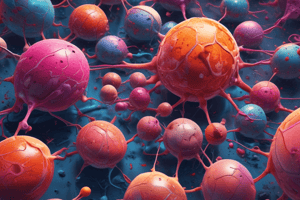Podcast
Questions and Answers
What is the primary difference between necrosis and apoptosis?
What is the primary difference between necrosis and apoptosis?
- The type of injury that triggers cell death
- The degree of cellular damage
- The speed at which cell death occurs
- The programming of the cell death process (correct)
Which of the following is NOT a cellular stress response?
Which of the following is NOT a cellular stress response?
- Heat shock proteins
- Oxidative stress response
- Autophagy
- Necrosis (correct)
What is the primary function of apoptosis?
What is the primary function of apoptosis?
- To regulate immune responses
- To induce tissue inflammation
- To eliminate damaged or unwanted cells (correct)
- To maintain cellular function
What is a characteristic of cellular adaptation?
What is a characteristic of cellular adaptation?
What is the consequence of necrosis?
What is the consequence of necrosis?
What is an example of a cellular stress response?
What is an example of a cellular stress response?
Flashcards are hidden until you start studying
Study Notes
Cell Injury, Death, and Adaptation
Necrosis
- Definition: Unprogrammed cell death, often resulting from severe injury or inflammation
- Causes: Ischemia, infection, toxins, trauma, metabolic disorders
- Characteristics:
- Cellular swelling
- Plasma membrane rupture
- Release of cellular contents
- Inflammation
- Tissue damage
- Consequences: Can lead to further tissue damage and organ dysfunction
Cellular Stress Responses
- Definition: Mechanisms that help cells cope with stress or injury
- Types:
- Cellular repair: Reversible changes to restore cellular function
- Cellular adaptation: Permanent changes to maintain cellular function
- Cell death: Irreversible changes leading to cell death
- Examples:
- Heat shock proteins (HSPs)
- Oxidative stress response
- Unfolded protein response (UPR)
- Autophagy
Apoptosis
- Definition: Programmed cell death, a controlled process of cellular self-destruction
- Causes: Genetic damage, DNA damage, growth factor withdrawal, immune response
- Characteristics:
- Cellular shrinkage
- Chromatin condensation
- Nuclear fragmentation
- Membrane blebbing
- Phagocytic removal of apoptotic cells
- Functions:
- Eliminate damaged or unwanted cells
- Maintain tissue homeostasis
- Regulate immune responses
- Prevent cancer development
Cell Injury and Death
- Necrosis: Unprogrammed cell death resulting from severe injury or inflammation, characterized by cellular swelling, plasma membrane rupture, and release of cellular contents, leading to inflammation and tissue damage.
- Causes of Necrosis: Ischemia, infection, toxins, trauma, and metabolic disorders.
Cellular Stress Responses
- Definition: Mechanisms that help cells cope with stress or injury, including cellular repair, cellular adaptation, and cell death.
- Types of Cellular Stress Responses:
- Cellular Repair: Reversible changes to restore cellular function.
- Cellular Adaptation: Permanent changes to maintain cellular function.
- Cell Death: Irreversible changes leading to cell death.
- Examples of Cellular Stress Responses:
- Heat Shock Proteins (HSPs): Protective proteins that help maintain protein function during stress.
- Oxidative Stress Response: Mechanisms that counteract oxidative damage to cells.
- Unfolded Protein Response (UPR): Response to misfolded proteins, helping to restore protein function.
- Autophagy: Process by which cells recycle damaged or dysfunctional components.
Apoptosis
- Definition: Programmed cell death, a controlled process of cellular self-destruction, characterized by cellular shrinkage, chromatin condensation, and nuclear fragmentation.
- Causes of Apoptosis: Genetic damage, DNA damage, growth factor withdrawal, and immune response.
- Functions of Apoptosis:
- Eliminate Damaged or Unwanted Cells: Remove cells that are damaged or no longer needed.
- Maintain Tissue Homeostasis: Regulate cell numbers to maintain tissue health.
- Regulate Immune Responses: Involved in immune response and prevention of autoimmune diseases.
- Prevent Cancer Development: Eliminate cells that could become cancerous.
Studying That Suits You
Use AI to generate personalized quizzes and flashcards to suit your learning preferences.




